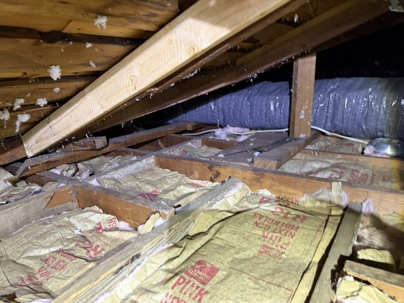When DIY or Budget Contractors Get It Wrong
If your attic has brand new insulation but your home still feels uncomfortable, it could be a costly mistake. Learn why choosing the wrong type—and installing it incorrectly—can waste your time and money in Oregon homes.
There’s a saying we hear a lot in home improvement: “You get what you pay for.” And in the case of one local homeowner in Springfield, Oregon, that couldn’t be more true.
Just one year ago, this customer paid out-of-pocket to have their attic insulated. The contractor said it would help lower energy bills and make the house more comfortable year-round.
Instead, they got:
- A freezing cold home in the winter
- A hot upstairs in the summer
- And zero improvement in comfort or efficiency
When the homeowner reached out to Dr. Energy Saver of Oregon, our Energy Consultant Monte Riddle climbed into the attic and immediately spotted the problem.
“Brand New Insulation, But Installed Wrong”
“I found that the insulation had been installed upside down, and worse—it was the wrong type altogether. The contractor used R-13 wall insulation, not attic insulation. For Oregon homes, attic insulation should start at R-25 minimum. This mistake basically made the whole project useless—and the homeowner had to pay twice to make it right.”
– Monte Riddle, Energy Consultant, Dr. Energy Saver of Oregon
What Went Wrong?
This wasn’t just a bad product. It was the wrong product in the wrong place.
The insulation was for walls, not attics. So what’s the difference? Wall insulation like R-13 is not thick enough for an attic, where rising heat and exposure demand higher R-values—typically R-38 to R-49 in the Pacific Northwest.
It was installed upside down…
Faced insulation (with paper backing) must be installed with the vapor barrier facing the interior of the home. When it’s installed backwards, it can trap moisture, cause mold growth, and lose its insulating power.
There was no air sealing. This is malpractice!
Without sealing gaps and penetrations, even good insulation won’t stop airflow. That means drafts in winter and heat build-up in summer, no matter what you paid.
What It Cost the Homeowner
The homeowner didn’t just lose money on ineffective insulation. They also dealt with:
- Higher utility bills
- Persistent discomfort
- Reduced indoor air quality
- A second round of costs to remove and reinstall insulation correctly
Why DIY or Budget Contractors Can Be Risky
Too often, general contractors or the average handyman take on insulation jobs without training in building science. They may mean well, but they’re not looking at the whole house system: air flow, vapor barriers, thermal boundaries, and energy loss patterns.
That’s where Dr. Energy Saver of Oregon makes the difference.
We’re not just blowing in insulation and calling it a day. Our team evaluates your home as a full system—one that deserves the right materials, correct installation, and long-term performance.
What to do moving forward?
Remove the incorrect insulation
Air seal the attic and all penetrations
Install high-performance R-49 attic insulation
Address ventilation and moisture control
Air seal the attic and all penetrations
Install high-performance R-49 attic insulation
Address ventilation and moisture control
Insulation Only Works When It’s Done Right
Don’t be fooled by low prices or promises from under qualified installers. Attic insulation is an investment in your home’s comfort, safety, and efficiency. One mistake (like using wall insulation instead of attic insulation) can cost you thousands!
You might be in the same situation.
If your attic was insulated in the last few years but your home still feels uncomfortable, it’s time to have it checked.
Proudly serving Eugene, Springfield, Corvallis, Albany, and surrounding areas.

